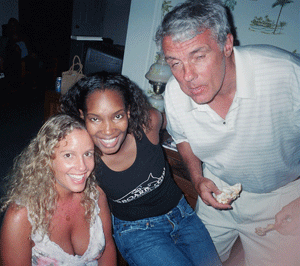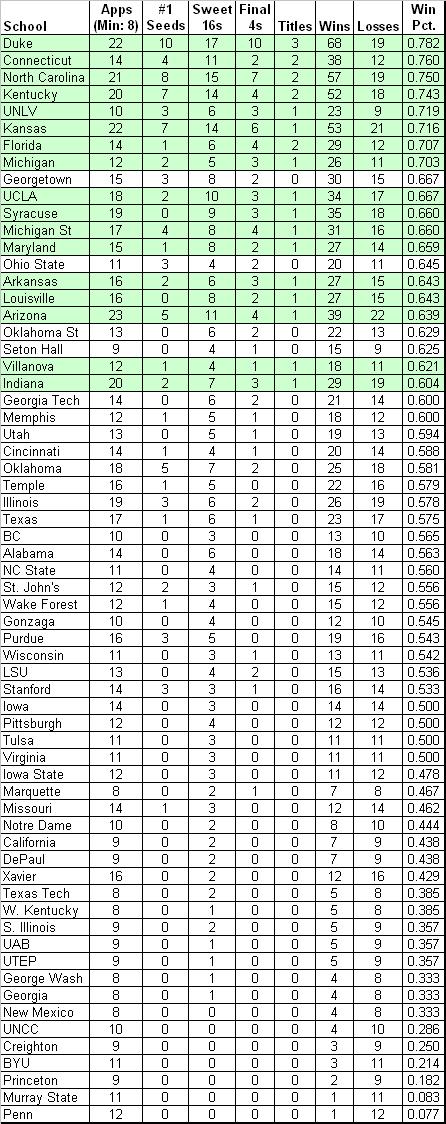ATB: Weekend Recap
Posted by rtmsf on December 11th, 2007
12.11.07
Recap. Apologies to everyone, but we’ve had a serious family matter to attend to in recent days, so we’ve lost a little of our mojo in keeping up with the blog. The good news is that Saturday was really the only decent day’s worth of games over the last four days. So here are the highlights (some of which we saw) from last weekend.
Games We Watched. Arizona 78, Illinois 72 (OT). The big news surrounding this game was the re-emergence of Lute Olson on Friday long enough for his wife to notify everyone that she is a money-grubbing Republican operative and Olson are getting a divorce and he needs time (i.e., the rest of the season) away from the program to put his personal life back together. What we saw: for the second consecutive game, Kevin O’Neill’s Wildcats got themselves down big early (12-0 to start the game), only to gut out a second half comeback led by Jerryd Bayless (20/5 assts) to win against a tough opponent. Sure, it took a fortuitous no-call for UA guard Nic Wise, who quite obviously signalled for a timeout that his team didn’t have, to get them into OT, but a road (Chicago) win is a road win. Arizona sophomore forward Jordan Hill added 23/14 for the Cats, who we’re starting to think might have a little toughness in them this year after all. As for the Illini, they have only themselves to blame with their feeble 10-22 from the foul line for the game. #19 Pittsburgh 79, Washington 78. This was another fantastic game. Pitt picked up a hard-earned road win in a venue where UW simply doesn’t lose very often (33 straight against non-conference opponents). The game was close throughout, and it was ultimately decided with a five-minute video review of Washington’s Justin Dentmon’s runner at the buzzer that dropped through the net after bouncing around the rim several times. In the olden days before video review of buzzer beaters, UW walks off with that win and Pitt goes home 8-1, but not now. The officials concluded (rightly, although it was extremely close) that Dentmon’s shot was after the horn and therefore Pitt was the winner, much to the communal chagrin of the Washington crowd. Great non-conf win for Pitt. #14 Indiana 70, Kentucky 51. We watched this one out of a sense of history and tradition of the sport, but we wish we hadn’t, in retrospect. E-Giddy didn’t even play and still the Hoosiers rolled up the Cats and smoked them like a fat Cohiba. The story of the game was that IU guard Jordan Crawford (20 pts on 5-10 shooting) completely and totally outplayed his older UK brother, Joe Crawford (10 pts on 4-15), to the point where even Billy Packer was gushing. If any game encapsulated the frustratingly enigmatic career of former HS stud Joe, this was it. DJ White added 16/13 for the Hoosiers (his fifth straight dub-dub), while UK’s only legit player, Patrick Patterson, finished with 15/5. Oh, and we don’t have the time nor inclination to get into all the Alex Legion nonsense, but if you’re interested, he’s leaving UK (possible destination: Michigan?) and ASoB discusses it much more in-depth than we can.
Other Good Games. #15 Marquette 81, Wisconsin 76. Tremendous win for Marquette, because Wisconsin just does not lose in the Kohl Center (28 in a row prior to this game). Surprisingly, it was the undersized Marquette interior players who played with abandon on the boards and won that battle (37-29) against the taller, beefier Wisconsin front line. Marquette is awfully tough to beat when Dominic James (20/5/6 assts) plays well. #13 Michigan St. 68, #21 BYU 61. This battle of ranked teams had upset written all over it, but give credit to MSU, who was down ten at the half on the road but managed to regain its composure and stick it to the Cougars in the second half (67% shooting). If you want an upset specialist for March, keep an eye on BYU as a #5-#7 seed, especially if their draw is out west. They’ve played UNC, Louisville and Michigan St. very tough already (defeating UL), and Trent Plaisted (19/8) is an interior stud. #5 UCLA 75, Davidson 63. Davidson must be getting tired of this same old song and dance by now: play a top ten team extremely well for about 30-35 minutes, only to have the other teams’ size and strength win out in the end. They have a really good team, but they probably should have scheduled more teams ranked in the 25-50 range in order to pick up a few more Ws (we still think they’ll beat NC State later this month). In this one, Davidson roared out to an 18-pt lead in Pauley Pavilion (32-14) before the Bruins awakened from their slumber and led by Luc Richard Mbah a Moute (21/8) and Kevin Love (12/12), took over the game. Davidson’s Stephen Curry didn’t shoot well (6-19) in a 15/4 performance. UCLA is showing signs of boredom, and their next really tough game isn’t until the Pac-10 schedule begins in January.
Upsets. It was a good upset Saturday. Dayton 70, #10 Louisville 65. The enigma known as Derrick Caracter signed a good behavior contract on Saturday morning, put up 16/7 in a home loss to Dayton, then proceeded to break said contract (curfew) that very night after the game. After getting busted by the coaches, he then stewed in his room for an hour before sneaking out AGAIN. Wow. So with Palacios and Padgett out injured until who knows when, and Caracter seemingly unable and unwilling to stay eligible, the word is that Pitino is tinkering with the idea of a five-guard lineup. A once promising season is bordering on the edge of disaster in Louisville these days. Dayton’s Brian Roberts lit up the Cards for 28 pts, as the Flyers (now 7-1) won against UL for the second straight year.
[vodpod id=ExternalVideo.444464&w=425&h=350&fv=session%3Dfsp_317%26domain%3Despn%26fspRoot%3Dhttp%3A%2F%2Fassets.espn.go.com%2Fmotion%2Ffsp%2FFSPRoot%26bgColor%3DECECEC%26bgImage%3Dhttp%3A%2F%2Fassets.espn.go.com%2Fmotion%2Ffsp%2FFSPRoot%2Fespnbg_playbtn.swf%3Fimg%3Dhttp%3A%2F%2Fassets.espn.go.com%2Fmedia%2Fmotion%2F2007%2F1208%2Fhu_071208ncb_dayton1v.jpg%2526showbutton%3Dtrue%2526buttonx%3D82%2526buttony%3D5%26playlistURL%3Dfalse%26playlistViewer%3Dfalse%26playlistParser%3Dfalse%26adType%3Dfalse%26adPauseEnabled%3Dtrue]
Rhode Island 91, Syracuse 89. Staying with the A10 over Big East theme, how did Syracuse shoot 54% at home and still lose? Well, it didn’t hurt that URI was 12-18 from three and made its FTs down the stretch. This might be one of those games that doesn’t look like much of an upset a month or two from now (URI is now 10-1. with the one loss at BC). Jonny Flynn had 21/10 for the Orange. Wright St. 43, #9 Butler 42. Butler just can’t get past these guys, especially in Dayton. Three of Butler’s last six losses were to Wright St., and the MO for each one has been the same – stop AJ Graves. Graves was held to 6 pts on 2-11 shooting in the high -scoring affair (only three players combined reached double figures). Butler may get all the hype, but Wright St. under Brad Brownell has once again announced that it will be a contender in the Horizon. Stephen F. Austin 66, Oklahoma 62. OU’s losses to Memphis and USC are understandable, but how does the same team that blitzed Tulsa by 26 and TCU by 24 in its previous two games turn around and lose to SFA at home?
[vodpod id=ExternalVideo.444467&w=425&h=350&fv=session%3Dfsp_847%26domain%3Despn%26fspRoot%3Dhttp%3A%2F%2Fassets.espn.go.com%2Fmotion%2Ffsp%2FFSPRoot%26bgColor%3DECECEC%26bgImage%3Dhttp%3A%2F%2Fassets.espn.go.com%2Fmotion%2Ffsp%2FFSPRoot%2Fespnbg_playbtn.swf%3Fimg%3Dhttp%3A%2F%2Fassets.espn.go.com%2Fmedia%2Fmotion%2F2007%2F1208%2Fhu_071208ncb_rhodeisland.jpg%2526showbutton%3Dtrue%2526buttonx%3D82%2526buttony%3D5%26playlistURL%3Dfalse%26playlistViewer%3Dfalse%26playlistParser%3Dfalse%26adType%3Dfalse%26adPauseEnabled%3Dtrue]
Other Ranked Teams.
- #3 Texas 80, Rice 54. Abrams, Augustin and James each with 18 pts.
- #4 Kansas 84, Depaul 66. Brandon Rush came off the bench for 13 pts and one bench warrant.
- #6 Duke 95, Michigan 67. Please, please, please end this series soon.
- #7 Georgetown 87, Jacksonville 55. steady as she goes for Georgetown (59% FG).
- #8 Washington St. 72, Portland St. 60. even more steady for Wazzu (69% eFG)
- #11 Texas A&M 109, Texas St. 73. We’re just amazed that A&M played 18 guys in this game.
- #16 Oregon 75, Utah 64. Another solid home win for Oregon.
- #17 Gonzaga 85, Cal St. Northridge 59. Micah Downs (19 pts) and Matt Bouldin (18) led the way.
- #23 Vanderbilt 90, Lipscomb 67. 26/10 for AJ Ogilvy as Vandy remains unbeaten. Could he be the next Bogut?
- #25 Villanova 101, Temple 93. Scottie Reynolds was huge (27/6/9) in this Big 5 matchup.
Other Notable Scores.
- Boston College 81, Maryland 78. BC is much better than everyone thought, Maryland much worse.
- Kansas St. 82, California 75. Cal shoots 51% and still loses their first game – three players with dub-dubs (Walker – 30/10; Beasley – 19/11; R. Anderson – 24/11).
- Illinois St. 62, Cincinnati 52. Hard to argue Cincy is better off w/o Thuggins at this point.
- Charlotte 71, S. Illinois 56. Make that three solid wins in a row for Charlotte.
- East Carolina 75, NC State 69. Sam Hinnant dropped 30 on the incredibly overrated Wolfpack. Anybody still got NCSU third in the ACC?
- St. Mary’s 69, San Diego St. 64. very nice road win for the Gaels (prior to tonight’s loss v. SIU)
- Kent St. 73, George Mason 55. Another solid mid-major win for the Golden Flashes.
- Georgia 72, Wake Forest 50. We still don’t think much of UGa, but Wake took it on the chin from the SEC last week.
- Fordham 88, NJIT 44. Stony Brook 62, NJIT 53. NJIT’s quest for winlessness continues (0-12). Avg. margin of defeat = 25.0 ppg. Next game: Thurs. at Rutgers.
On Tap Today (all times EST).
- Xavier (-19) v. Cincinnati (ESPN2) 7pm – we love the Crosstown Shootout – XU should roll this year, though.
- Maryland (-8.5) v. Ohio 8pm. the way the Terps have been playing, this could be interesting…
- Wisconsin (-13.5) v. Wisconsin-Milwaukee (ESPN FC) 8pm – the battle of Cheeseheads.
- Vanderbilt (-3) v. Depaul (ESPN Classic) 8pm – winnable road game for Vandy to remain unbeaten.
- Arkansas (NL) v. Texas-San Antonio (ESPN FC) 8pm – we still haven’t gotten a good feel for the Hawgs.
- Colorado (-5) v. New Orleans 9pm – the Privateers with another shot at defeating a BCS team.
- Boston College (-4) v. Massachusetts (ESPNU) 9pm – the battle of Chowderheads.






































.JPG)













